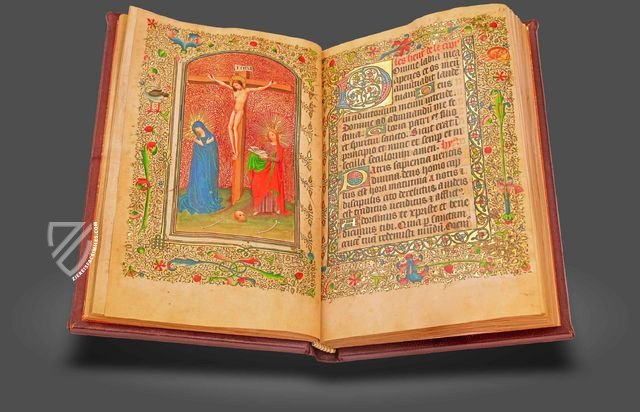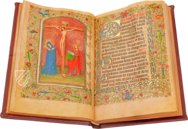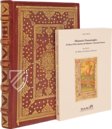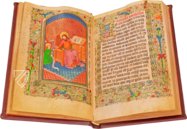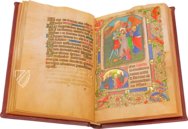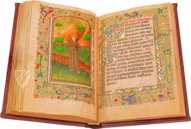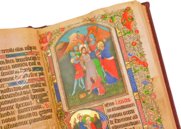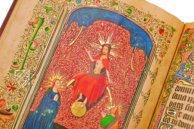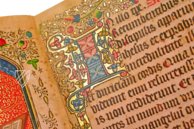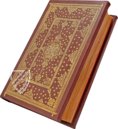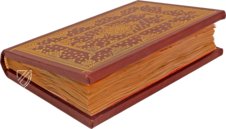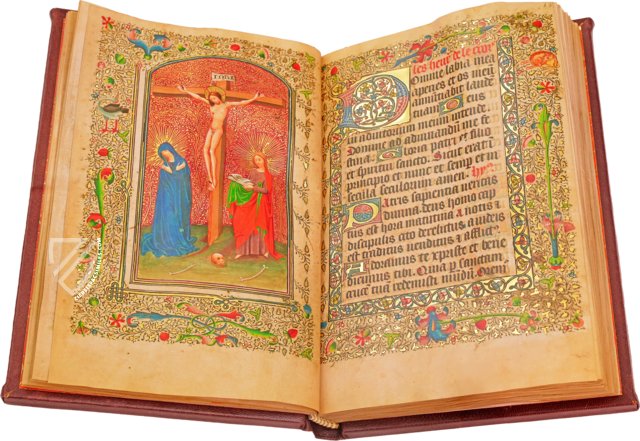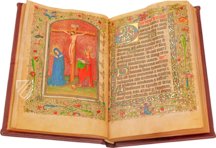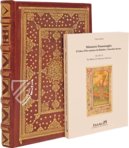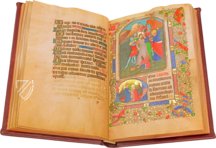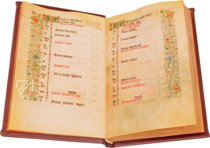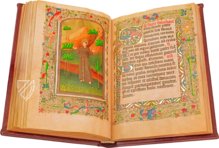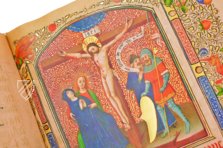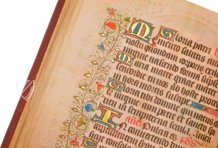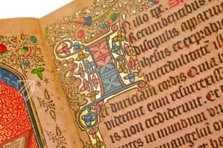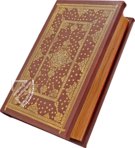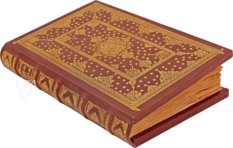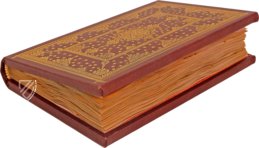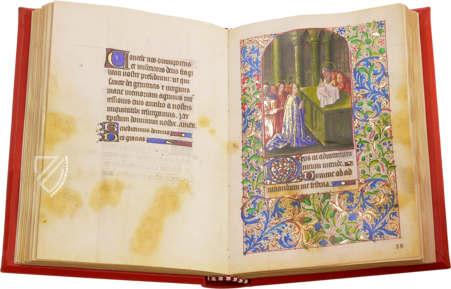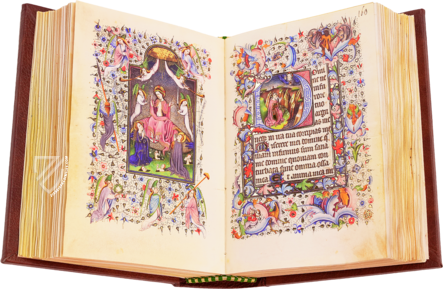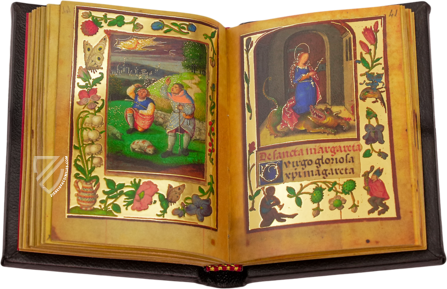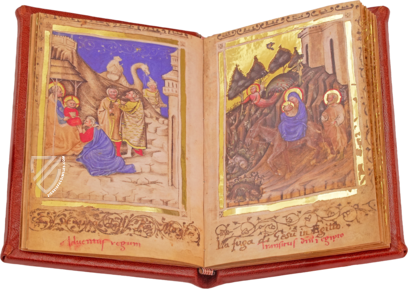Walters Book of Hours W.173
Between 1440 and 1450, several Flemish book artists known as the Masters of the Gold Scrolls created a true gem of Gothic book illumination for a mysterious woman with a particular fondness for Franciscan and French saints: the so-called Walters Book of Hours. Of the 23 large to full-page miniatures that accompany the prayers with Christian iconography and depictions of saints, 17 have been preserved and have lost little of their original splendor. The beautiful scroll ornament made of brush gold, which adorns most of the backgrounds and was eponymous for the group of artists, together with the multicolored figurative scenes and the ornamental book decoration, still lends the manuscript a wonderful opulence today. It is a unique masterpiece by the Masters of the Gold Scrolls, which does not correspond to the group's usual color palette, but can be reliably attributed to it through several artist stamps – a wonderful testimony to their art at the height of their creative powers!
Walters Book of Hours W.173
The so-called Walters Book of Hours, kept under the signature W.173 at the Walters Art Museum in Baltimore, is without question one of the most beautiful works among the magnificently illuminated books of hours by the Masters of the Gold Scrolls. This group of talented but still anonymous book artists was active in Flanders between 1410 and 1460, creating gold-decorated book treasures for wealthy clients. The group got its provisional name from the beautiful gold scroll ornament with which they uniquely decorated the backgrounds of many miniatures. In the Walters Book of Hours, created around 1440–1450, the gold scrolls appear exclusively on dark red backgrounds, lending the miniatures a special depth and opulence.
Gold-decorated Images for Private Devotion
In addition to the gold scroll backgrounds, some images also feature punched full gold backgrounds, while others already reflect the slowly emerging naturalism and show figures in front of landscapes with skies. In total, the extensive prayer texts were accompanied by eight three-quarter-page miniatures, each accompanied by a historiated initial, and 15 full-page miniatures. Six of the latter have been lost over time, which is not surprising since they were glued into the manuscript on individual sheets after binding – a godsend for later art dealers and collectors who, especially in the 19th century, helped themselves to medieval book treasures that were no longer in use.
Imaginative Book Decoration
The gold-decorated illumination is complemented by numerous smaller decorated borders and, above all, 32 wonderful inhabited full borders, each of which contains at least one small drollerie. These imaginative hybrid creatures climb among the vines, flowers, and fruits and are a charming expression of medieval humor. In addition to the figurative elements, the text is structured by means of large-format ornamental initials and countless small champie initials in shiny gold. A beautiful testimony to the Gothic art of the Flemish Masters of the Gold Scrolls!
An Official Work of the Masters of the Gold Scrolls
While a single hand was responsible for the text written with calligraphic precision, the magnificent illumination was executed by several hands. Some miniatures are marked with a red “Tau” as the work of the Masters of the Gold Scrolls, so it can be assumed that all the illuminators involved belonged to this group. The notarized artist's stamp served as their identification mark – a practice that spread among officially recognized illuminators in Flanders from 1426 onwards in order to distinguish their works from “illegal” copies.
Gold Scrolls for an Unknown Believer
The Masters of the Gold Scrolls created the precious manuscript for a woman who remains unidentified to this day – either commissioned directly by her or by someone who gave her the codex as a gift. References to the pious user are provided by the recurring initials A and M and a coat of arms indicating land ownership in Amiens and Corbie. She was also apparently particularly attached to Franciscan and French saints, as evidenced by the calendar, the litany, and the suffrages. St. Francis even appears on fol. 73v in a full-page miniature, followed by a suffrage (a short prayer following a specific pattern) to the saint. The Latin book of hours concludes with a French-language prayer to the Virgin Mary, to whom the owner may have had a special connection. Together with the coat of arms and the French saints, this could also be an indication of a French origin of the enigmatic woman.
Translated with DeepL.com (free version)
Codicology
- Alternative Titles
- Orationes in Laudem Francisci
Walters Stundenbuch W.173 - Size / Format
- 214 pages / 25.7 × 17.2 cm
- Origin
- Belgium
- Date
- Ca. 1440–1450
- Epochs
- Style
- Genre
- Script
- Textura
- Illustrations
- 17 miniatures, 9 of which are full-page and 8 three-quarter-page, 8 historiated, 15 ornamental and numerous smaller decorated initials, 32 inhabited full borders and 108 smaller decorated borders
- Content
- Calendar, Gospel sequences, Hours of the Cross, Hours of the Holy Spirit, Hours of the Virgin, suffrages, Seven Penitential Psalms, litany, petitions, collects, Fifteen Joys of the Virgin, Seven Requests of our Lord, other prayers, French prayer to the Vi
- Artist / School
- Masters of the Gold Scrolls
- Previous Owners
- Jean-Baptiste Verdussen
Alfred Werlé
Henry Walters
#1 Orationes in Laudem Francisci
Language: Italian
- Treatises / Secular Books
- Apocalypses / Beatus
- Astronomy / Astrology
- Bestiaries
- Bibles / Gospels
- Chronicles / History / Law
- Geography / Maps
- Saints' Lives
- Islam / Oriental
- Judaism / Hebrew
- Single Leaf Collections
- Leonardo da Vinci
- Literature / Poetry
- Liturgical Manuscripts
- Medicine / Botany / Alchemy
- Music
- Mythology / Prophecies
- Psalters
- Other Religious Books
- Games / Hunting
- Private Devotion Books
- Other Genres
- Afghanistan
- Armenia
- Austria
- Belgium
- Belize
- Bosnia and Herzegovina
- China
- Colombia
- Costa Rica
- Croatia
- Cyprus
- Czech Republic
- Denmark
- Egypt
- El Salvador
- Ethiopia
- France
- Germany
- Greece
- Guatemala
- Honduras
- Hungary
- India
- Iran
- Iraq
- Israel
- Italy
- Japan
- Jordan
- Kazakhstan
- Kyrgyzstan
- Lebanon
- Liechtenstein
- Luxembourg
- Mexico
- Morocco
- Netherlands
- Palestine
- Panama
- Peru
- Poland
- Portugal
- Romania
- Russia
- Serbia
- Spain
- Sri Lanka
- Sweden
- Switzerland
- Syria
- Tajikistan
- Turkey
- Turkmenistan
- Ukraine
- United Kingdom
- United States
- Uzbekistan
- Vatican City
- A. Oosthoek, van Holkema & Warendorf
- Aboca Museum
- Ajuntament de Valencia
- Akademie Verlag
- Akademische Druck- u. Verlagsanstalt (ADEVA)
- Aldo Ausilio Editore - Bottega d’Erasmo
- Alecto Historical Editions
- Alkuin Verlag
- Almqvist & Wiksell
- Amilcare Pizzi
- Andreas & Andreas Verlagsbuchhandlung
- Archa 90
- Archiv Verlag
- Archivi Edizioni
- Arnold Verlag
- ARS
- Ars Magna
- ArtCodex
- AyN Ediciones
- Azimuth Editions
- Badenia Verlag
- Bärenreiter-Verlag
- Belser Verlag
- Belser Verlag / WK Wertkontor
- Benziger Verlag
- Bernardinum Wydawnictwo
- BiblioGemma
- Biblioteca Apostolica Vaticana (Vaticanstadt, Vaticanstadt)
- Bibliotheca Palatina Faksimile Verlag
- Bibliotheca Rara
- Boydell & Brewer
- Bramante Edizioni
- Bredius Genootschap
- Brepols Publishers
- British Library
- C. Weckesser
- Caixa Catalunya
- Canesi
- CAPSA, Ars Scriptoria
- Caratzas Brothers, Publishers
- Carus Verlag
- Casamassima Libri
- Centrum Cartographie Verlag GmbH
- Chavane Verlag
- Christian Brandstätter Verlag
- Circulo Cientifico
- Club Bibliófilo Versol
- Club du Livre
- CM Editores
- Collegium Graphicum
- Collezione Apocrifa Da Vinci
- Comissão Nacional para as Comemorações dos Descobrimentos Portugueses
- Coron Verlag
- Corvina
- CTHS
- D. S. Brewer
- Damon
- De Agostini/UTET
- De Nederlandsche Boekhandel
- De Schutter
- Deuschle & Stemmle
- Deutscher Verlag für Kunstwissenschaft
- DIAMM
- Droz
- E. Schreiber Graphische Kunstanstalten
- Ediciones Boreal
- Ediciones Grial
- Ediclube
- Edições Inapa
- Edilan
- Editalia
- Edition Deuschle
- Edition Georg Popp
- Edition Leipzig
- Edition Libri Illustri
- Editiones Reales Sitios S. L.
- Éditions de l'Oiseau Lyre
- Editions Medicina Rara
- Editorial Casariego
- Editorial Mintzoa
- Editrice Antenore
- Editrice Velar
- Edizioni Edison
- Egeria, S.L.
- Eikon Editores
- Electa
- Emery Walker Limited
- Enciclopèdia Catalana
- Eos-Verlag
- Ephesus Publishing
- Ernst Battenberg
- Eugrammia Press
- Extraordinary Editions
- Fackelverlag
- Facsimila Art & Edition
- Facsimile Editions Ltd.
- Facsimilia Art & Edition Ebert KG
- Faksimile Verlag
- Feuermann Verlag
- Folger Shakespeare Library
- Franco Cosimo Panini Editore
- Friedrich Wittig Verlag
- Fundación Hullera Vasco-Leonesa
- G. Braziller
- Gabriele Mazzotta Editore
- Gebr. Mann Verlag
- Gesellschaft für graphische Industrie
- Getty Research Institute
- Giovanni Domenico de Rossi
- Giunti Editore
- Graffiti
- Grafica European Center of Fine Arts
- Guido Pressler
- Guillermo Blazquez
- Gustav Kiepenheuer
- H. N. Abrams
- Harrassowitz
- Harvard University Press
- Helikon
- Hendrickson Publishers
- Henning Oppermann
- Herder Verlag
- Hes & De Graaf Publishers
- Hoepli
- Holbein-Verlag
- Houghton Library
- Hugo Schmidt Verlag
- Idion Verlag
- Il Bulino, edizioni d'arte
- ILte
- Imago
- Insel Verlag
- Insel-Verlag Anton Kippenberger
- Instituto de Estudios Altoaragoneses
- Instituto Nacional de Antropología e Historia
- Istituto dell'Enciclopedia Italiana - Treccani
- Istituto Ellenico di Studi Bizantini e Postbizantini
- Istituto Geografico De Agostini
- Istituto Poligrafico e Zecca dello Stato
- Italarte Art Establishments
- Jan Thorbecke Verlag
- Johnson Reprint Corporation
- Josef Stocker
- Josef Stocker-Schmid
- Jugoslavija
- Karl W. Hiersemann
- Kasper Straube
- Kaydeda Ediciones
- Kindler Verlag / Coron Verlag
- Kodansha International Ltd.
- Konrad Kölbl Verlag
- Kurt Wolff Verlag
- La Liberia dello Stato
- La Linea Editrice
- La Meta Editore
- Lambert Schneider
- Landeskreditbank Baden-Württemberg
- Leo S. Olschki
- Les Incunables
- Liber Artis
- Library of Congress
- Libreria Musicale Italiana
- Lichtdruck
- Lito Immagine Editore
- Lumen Artis
- Lund Humphries
- M. Moleiro Editor
- Maison des Sciences de l'homme et de la société de Poitiers
- Manuscriptum
- Martinus Nijhoff
- Maruzen-Yushodo Co. Ltd.
- MASA
- Massada Publishers
- McGraw-Hill
- Metropolitan Museum of Art
- Militos
- Millennium Liber
- Müller & Schindler
- Nahar - Stavit
- Nahar and Steimatzky
- National Library of Wales
- Neri Pozza
- Nova Charta
- Oceanum Verlag
- Odeon
- Orbis Mediaevalis
- Orbis Pictus
- Österreichische Staatsdruckerei
- Oxford University Press
- Pageant Books
- Parzellers Buchverlag
- Patrimonio Ediciones
- Pattloch Verlag
- PIAF
- Pieper Verlag
- Plon-Nourrit et cie
- Poligrafiche Bolis
- Presses Universitaires de Strasbourg
- Prestel Verlag
- Princeton University Press
- Prisma Verlag
- Priuli & Verlucca, editori
- Pro Sport Verlag
- Propyläen Verlag
- Pytheas Books
- Quaternio Verlag Luzern
- Reales Sitios
- Recht-Verlag
- Reichert Verlag
- Reichsdruckerei
- Reprint Verlag
- Riehn & Reusch
- Roberto Vattori Editore
- Rosenkilde and Bagger
- Roxburghe Club
- Salerno Editrice
- Saltellus Press
- Sandoz
- Sarajevo Svjetlost
- Schöck ArtPrint Kft.
- Schulsinger Brothers
- Scolar Press
- Scrinium
- Scripta Maneant
- Scriptorium
- Shazar
- Siloé, arte y bibliofilia
- SISMEL - Edizioni del Galluzzo
- Sociedad Mexicana de Antropología
- Société des Bibliophiles & Iconophiles de Belgique
- Soncin Publishing
- Sorli Ediciones
- Stainer and Bell
- Studer
- Styria Verlag
- Sumptibus Pragopress
- Szegedi Tudomànyegyetem
- Taberna Libraria
- Tarshish Books
- Taschen
- Tempus Libri
- Testimonio Compañía Editorial
- Thames and Hudson
- The Clear Vue Publishing Partnership Limited
- The Facsimile Codex
- The Folio Society
- The Marquess of Normanby
- The Richard III and Yorkist History Trust
- Tip.Le.Co
- TouchArt
- TREC Publishing House
- TRI Publishing Co.
- Trident Editore
- Tuliba Collection
- Typis Regiae Officinae Polygraphicae
- Union Verlag Berlin
- Universidad de Granada
- University of California Press
- University of Chicago Press
- Urs Graf
- Vallecchi
- Van Wijnen
- VCH, Acta Humaniora
- VDI Verlag
- VEB Deutscher Verlag für Musik
- Verlag Anton Pustet / Andreas Verlag
- Verlag Bibliophile Drucke Josef Stocker
- Verlag der Münchner Drucke
- Verlag für Regionalgeschichte
- Verlag Styria
- Vicent Garcia Editores
- W. Turnowski Ltd.
- W. Turnowsky
- Waanders Printers
- Wiener Mechitharisten-Congregation (Wien, Österreich)
- Wissenschaftliche Buchgesellschaft
- Wissenschaftliche Verlagsgesellschaft
- Wydawnictwo Dolnoslaskie
- Xuntanza Editorial
- Zakład Narodowy
- Zollikofer AG

